In this week's not-to-be-sniffed-at infectious episode of the naked scientists, we find out the facts of flu, including how the virus hijacks your cells, how new strains of the virus emerge to trigger epidemics and pandemics, and how scientists can combat the threat with vaccines. Also under the microscope is a new technique to identify viruses within just 2 hours, providing patients with a fast track to the right treatment! Also, how bone marrow transplants can overcome organ rejection, how to stop a terrorist with a mobile phone, and the new material 30 times blacker than our current blackest black! Plus, in kitchen science, we'll be pouring cold water on claims of centrifugal force...
In this episode

- Why didn't I catch the flu?
Why didn't I catch the flu?
We put this question to Dr John Wood:
Well, I don't know the particular circumstances. It's possible, I hope, that maybe he had a vaccine but maybe not. He could have been exposed to flu in the past which gave him some immunity. Maybe he didn't know he'd been exposed to flu in the past. It may have been a kind of sub-clinical infection he didn't notice. I expect he had some kind of immunity.
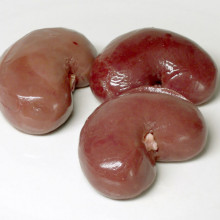
Organ Transplants without Rejection
Four out of five patients participating in a recent kidney transplant trial in America have been able to stop using immune-suppressing drugs.
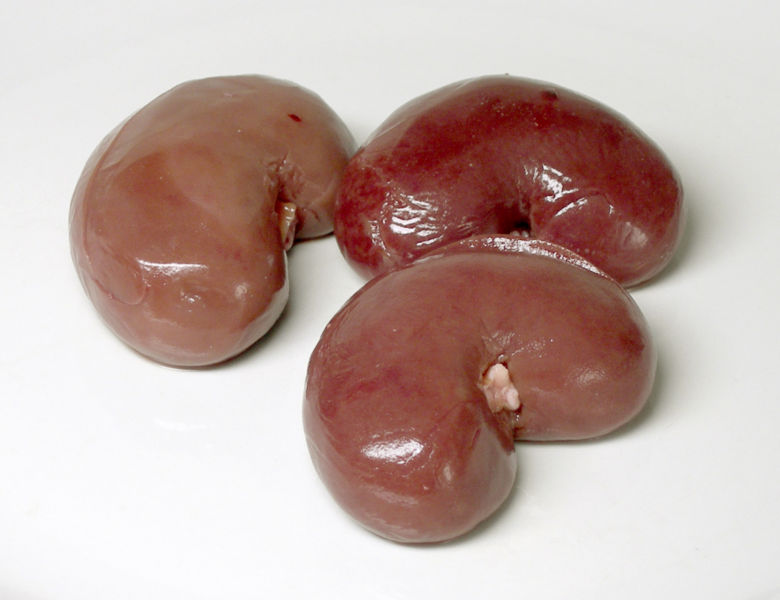 The patients, aged 22-46 years old, had all developed kidney failure for different reasons. Prior to receiving the donor organ each of the patients received a course of drugs to partially destroy their bone marrow and the T lymphocytes, white blood cells that recognise and reject foreign tissue. After this "conditioning" regimen was complete the patients underwent a combined transplant during which they received the new donor kidney and were also injected with their donor's bone marrow cells.
The patients, aged 22-46 years old, had all developed kidney failure for different reasons. Prior to receiving the donor organ each of the patients received a course of drugs to partially destroy their bone marrow and the T lymphocytes, white blood cells that recognise and reject foreign tissue. After this "conditioning" regimen was complete the patients underwent a combined transplant during which they received the new donor kidney and were also injected with their donor's bone marrow cells.
The results have been striking. Between nine and fourteen months after each transplant all but one of the patients have been able to stop taking any immunosuppressive drugs, and their kidneys remain healthy without any signs of rejection up to 5 years later. The scientists think that the transplantation of the donor bone marrow triggers the recipient's body to develop "tolerance" to the foreign organ, possibly by re-educating the recipient's white blood cells into ignoring what was previously viewed as hostile.
According to senior study author David Sachs from the Massachusetts General Hospital Transplantation Biology Research Center in Boston, "we are very encouraged by our initial success in inducing tolerance. While we need to study this approach in a larger group of patients before it is ready for broad clinical use, this is the first time that tolerance to a series of mismatched transplants has been intentionally and successfully induced."
The findings will almost certainly come as welcome news to the thousands of patients who face a twice-weekly trek to their nearest hospital for dialysis whilst they wait for a suitable donor organ to be found.
Cell phones to Detect Nuclear Terrorism
One of the biggest nightmares of the police and security services is a dirty bomb, this is where a terrorist blows up a conventional bomb surrounded with radioactive material. This is not a real nuclear bomb, but could make a small area radioactive for a long time, and create a huge amount of panic. The real headache is that without special equipment is is very hard to tell if something is radioactive so you could walk down a street with a bag full of nuclear waste without being noticed.
R esearchers at Purdue university and a consulting scientists called Andrew Longman have come up with a possible solution by taking advantage of mobile phones. The idea is to put a small cheap solid state radiation detector in as many mobile phones as possible. Many mobile phones especially in the US have positioning devices built into them, so if a phone detects more than a certain level of radiation it can automatically call into a base station and report the radiation level and its position.
esearchers at Purdue university and a consulting scientists called Andrew Longman have come up with a possible solution by taking advantage of mobile phones. The idea is to put a small cheap solid state radiation detector in as many mobile phones as possible. Many mobile phones especially in the US have positioning devices built into them, so if a phone detects more than a certain level of radiation it can automatically call into a base station and report the radiation level and its position.
Andrew has developed software that will put together hundreds of these reports and only give a warning if several phones detect radiation which is in the same place or moving at a sensible speed and could be from the same source.
The whole system would be dependent on getting mobile phone manufacturers to put detectors into enough phones that you can build up a useful network of detectors, not picking up legitimately radioactive things such a people undergoing a course of nuclear medicine, and persuading people they want to carry a phone that is reporting back to the government all the time.

Pregnancy-Caffeine Combo Bad Idea
Researchers have shown that caffeine exposure is linked to an increase risk of miscarriage.
 De-Kun Li, from Californian health insurer Kaiser-Permanente, followed 1063 women during the first twenty weeks of their pregnancies or until they had a miscarriage. Amongst the details collected, the participants were asked about their caffeine consumption. The data is published in the American Journal of Obstetrics and Gynecology and shows that women drinking more than 200 milligrams of caffeine per day - the equivalent to just over one cup of coffee - had a two-fold rise in their miscarriage risk.
De-Kun Li, from Californian health insurer Kaiser-Permanente, followed 1063 women during the first twenty weeks of their pregnancies or until they had a miscarriage. Amongst the details collected, the participants were asked about their caffeine consumption. The data is published in the American Journal of Obstetrics and Gynecology and shows that women drinking more than 200 milligrams of caffeine per day - the equivalent to just over one cup of coffee - had a two-fold rise in their miscarriage risk.
But it wasn't just coffee that was to blame - all caffeinated beverages including fizzy drinks, tea and even hot chocolate had the same effect. According to Li, caffeine might be triggering vaso-constriction - blood vessel narrowing - in the placenta, cutting blood flow and the delivery of oxygen and collection of waste products from the developing foetus. Alternatively, he says, caffeine may be directly toxic to a foetus. Either way he suggests that women avoid caffeine altogether during pregnancy. "It's not a big sacrifice," he says.
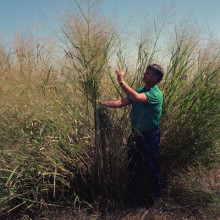
Grass could be the fuel of the future
Transport systems have been powered by grass for hundreds of years in the form of horses, but it looks like it will be a fuel of the future as well. Farmers in Nebraska and the Dakotas have been taking part in a study on Switchgrass a perennial native American plant, that often grows as a weed.
They have been studying how much energy it takes to grow the grass, including fuel to power the tractors, and the energy required to make the fertilizer used to speed its growth and to produce the seeds.
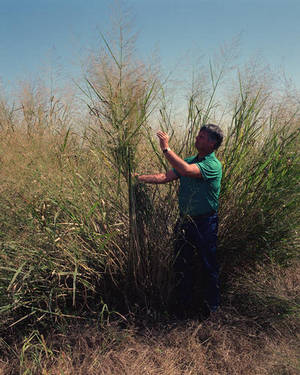 Once the grass is established they have found that it produces 5-11 tonnes of grass per hectare depending on the weather which translates into ethanol with at least 5 ½ times the energy that was put in, which compares very favourably to other methods of making biofuels based on fermenting foodstuffs such as maize which only produce 1 ¼ times the energy that is put in.
Once the grass is established they have found that it produces 5-11 tonnes of grass per hectare depending on the weather which translates into ethanol with at least 5 ½ times the energy that was put in, which compares very favourably to other methods of making biofuels based on fermenting foodstuffs such as maize which only produce 1 ¼ times the energy that is put in.
The major unknown in this calculation is the large scale conversion of cellulose, which makes up most of the energy in grass, into ethanol which conventional yeast fermentation can't do. Conventional methods of doing this involve using large amounts of enzymes to break down the cellulose into sugars which yeasts can then break down.
And in another related story this week a company called Coskata in America has developed a new strategy and they claim to be able to produce ethanol at about $1 a gallon or about 12p a litre. This relies of heating up the vegetable material without oxygen to form a mixture of carbon monoxide and and hydrogen known as syngas. This gas is then fed through a tank full of bacteria which convert the syngas into ethanol.
So with any luck a form of biofuel which is actually useful at combatting global warming may be around the corner.
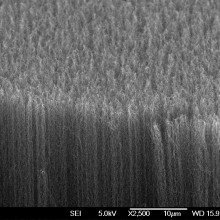
11:21 - The Blackest Black
The Blackest Black
with Professor Pulickel Ajayan, Rensselaer Polytechnic
One big thing that's been in the news in the last weeks or so is a story about the blackest black that's ever been seen. Using carbon nanotubes Professor Pulickel Ajayan from Rensselaer Polytechnic has developed a material that he says absorbs over 99.9% of all the light that falls on it. That's 30 times darker than our current benchmark, or what we call black.
Chris - Hello Pulickel, thank you for joining us.
Pulickel - Thank you.
Chris - So why have you done this? What is this stuff?
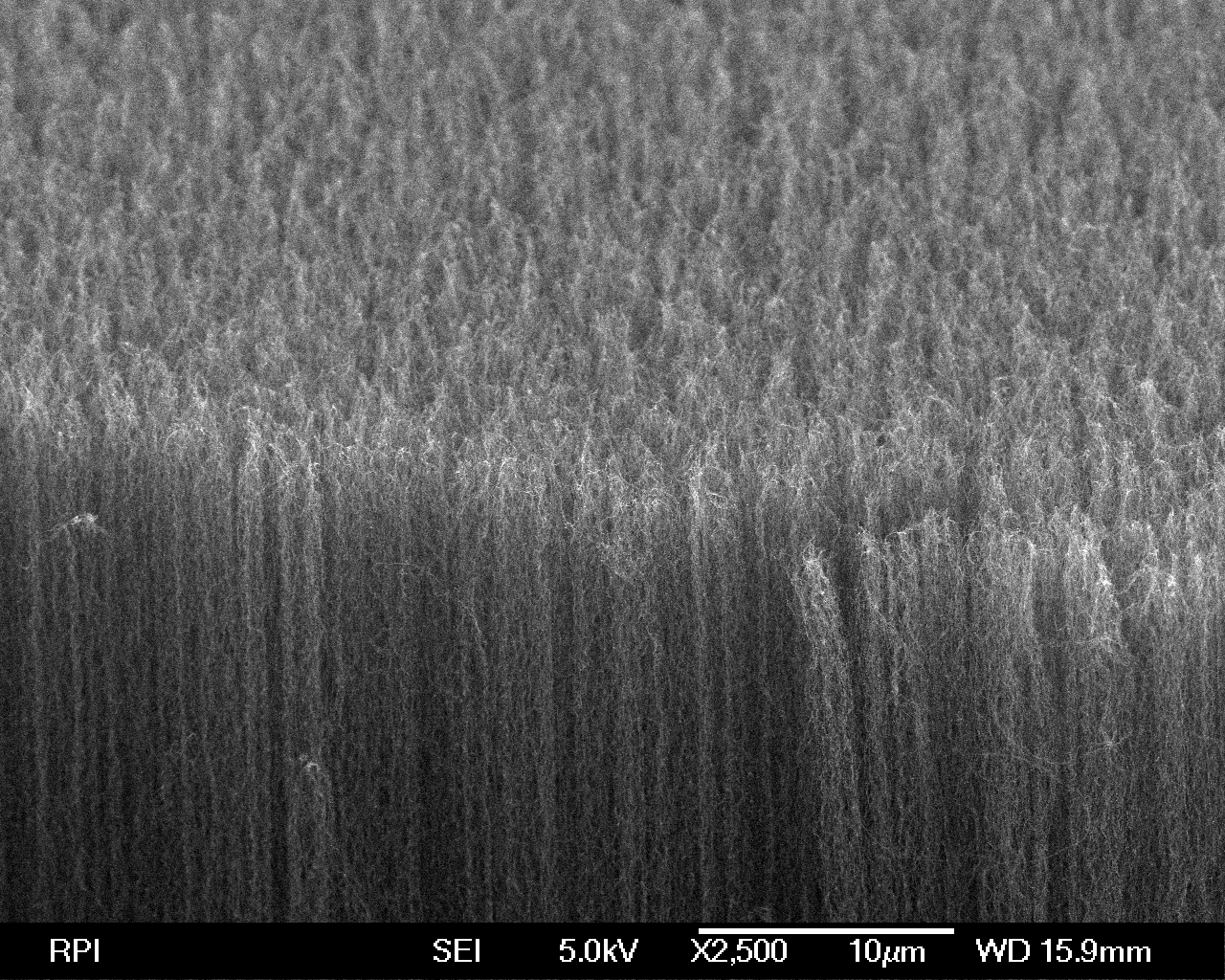 Pulickel - Well, an ideal black material absorbs light at all wavelengths and all angles, basically. There were some speculations published by Spanish and English scientists who said if you take these tiny carbon cylinders and organise them into an array you can get very high absorbancy and very low integral refraction. Of course to get a very black substance you also need to minimise the reflectants on the surface and you can do that by creating a surface softness.
Pulickel - Well, an ideal black material absorbs light at all wavelengths and all angles, basically. There were some speculations published by Spanish and English scientists who said if you take these tiny carbon cylinders and organise them into an array you can get very high absorbancy and very low integral refraction. Of course to get a very black substance you also need to minimise the reflectants on the surface and you can do that by creating a surface softness.
Chris - So how does your technique actually work? If I was to zoom in with a very powerful microscope on the surface that you've created that is very back, what would I see?
Pulickel - Right, you will see nano scale cylinders of these carbon materials. A nanometre is about a billionth of a metre so you have several of these structures that are just randomly placed on the surface. That's what actually decreases the surface reflectance.
Chris - So you have these tiny tubes. I mean, looking at the scale of them that would make them 400 or 500 times thinner than a human hair wouldn't it?
Pulickel - It would be more than that, about 3 orders of magnitude smaller than..[a human hair]
Chris - So you have these peppered all over a surface? How do you make them..
Pulickel - There is a periodicity of these structures in the bulk of the material. In the surface you have a random array so it satisfies both criteria: that you have a very highly absorbent material and also it reflects very little on the surface.
Chris - So how does it actually work to mean that so little light comes back off?
Pulickel - It's basically almost like the light enters this material and it gets trapped because of this periodicity. That's why you have a very low index of refraction.
Chris - How would you see this being used? It's one thing to get into the Guinness Book of Records for the World's blackest substance but how is this actually useful?
Pulickel - It was done mostly from an academic curiosity but something that absorbs a lot of light would be useful as a solar collector. Again, in order to make this into an appropriate device you would have to worry about some other losses from material as a result of light. Certainly it'll be a very strong absorber. It could also be useful in areas where you want a very black background so that you can have a high definition of the areas which are light and black.
Chris - So you could use it to trap sunlight which would make solar cells more efficient. What about other things? Does it work outside the visible spectrum of light? Of course, there's much more to light than just what we can see: things like radio waves, microwaves and at the other end of the scale x-rays and gamma waves.
Pulickel - Absolutely, that's our hope. We have not done these things yet but we are in the process of doing the high end IR and other wavelengths. That'll be much more interesting from various points of view.
Chris - Thank you very much, Pulickel. Good to have you on the show.
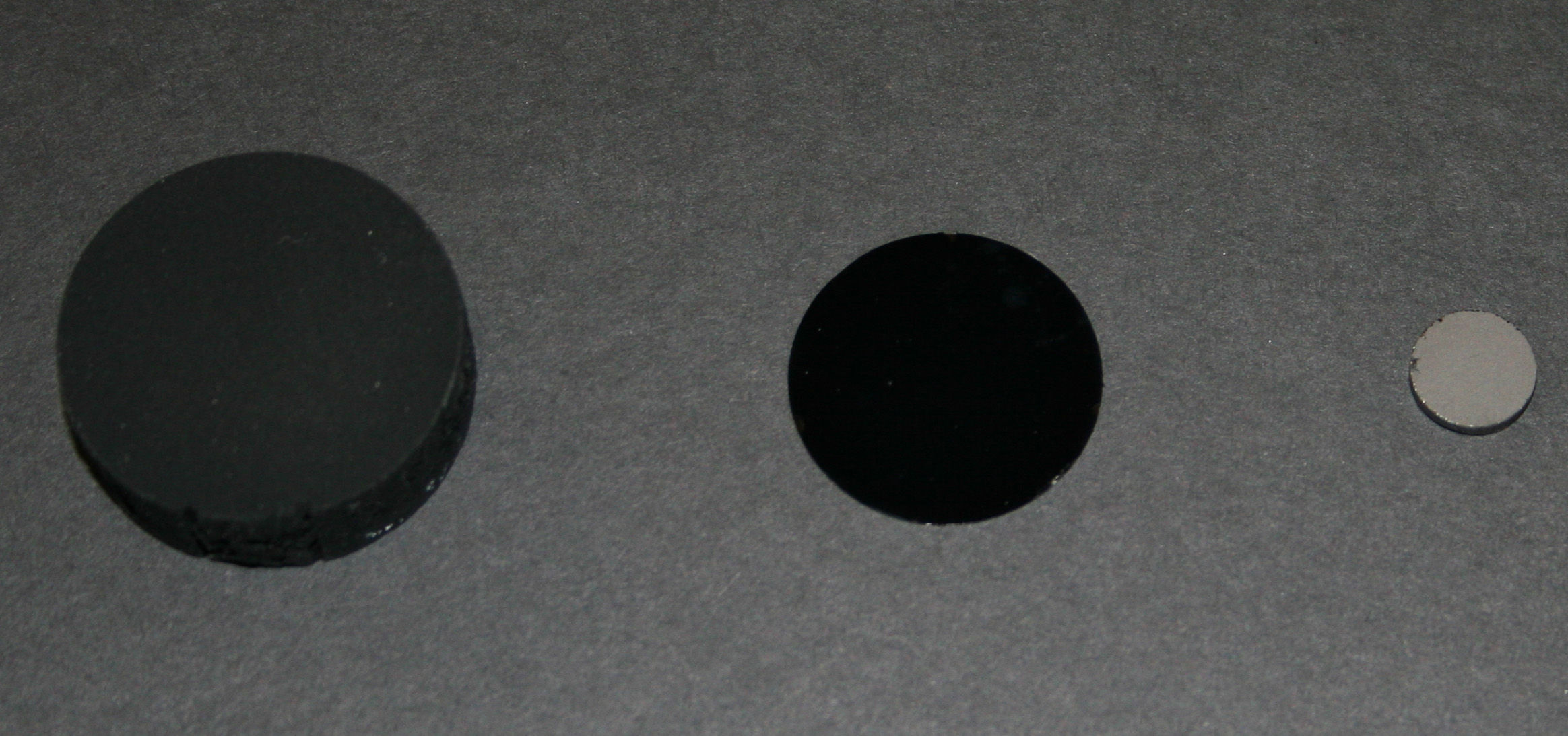

How much energy do fluorescent lights take to turn on?
Last week Derek in Belgium asked a question about fluorescent lights, but we didn't know what that period of time was to make switching off a light more efficient than leaving it on.
I have to say a very big thank you to Shia Frederick and also to Kurt Challetts who both found me the answer and they've sent me some references.
Based on experimentation they have concluded that - these references they've sent me - a fluorescent light uses as much energy getting started as it does to run for 23.3 seconds.
In other words, that is a bit of a myth about leaving it on for very long. If you're going to be in the room and gone for less than 23.3 seconds there's no point turning it on, basically. You might as well turn it off because it uses not very much more energy.
In comparison, an LED has to run for 1.28 seconds before it uses as much energy. The good old-fashioned incandescent lamp: 0.36 seconds before it's used as much energy running as it does to turn it on.
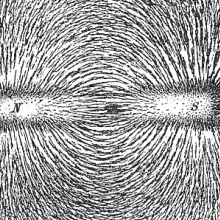
Why are some magnets stronger than others?
Dave Ansell answered this attractive question...
On a fundamental, minute scale iron, nickel and cobalt atoms have more electrons orbiting in one direction than the other. This means they produce little tiny currents like electromagnets.
With ferromagnetic things - like iron, nickel and cobalt - these tend to like lining up into areas. Normally if you just take these areas, the north poles of these little areas will attract south poles of other little areas.
They'll all wind up going into circles and ovals in magnetism. If you put them in a strong magnetic field they'll all line up.
Normally with iron, if you take the magnetic field off, most of them will realign randomly. They get all jiggled up and end up pointing in random directions again.
With very strong magnets, like rare earth magnets, the structure of the alloy tends to make it very hard to change the direction of the magnetic field. This means that more of them stay lines up, and you get a stronger magnet.
Why do babies have a quick heartbeat and elephants a slow one?
You're on the right lines there, George. The reason is that if you think of a heart as almost a sphere and the volume of a sphere is given by the mathematical formula 4/3πr3. That's the volume of blood that a heart could hold. You could work out how much output's coming out of your heart by multiplying the number of times per minute the heart beats (the heart rate) by what's called the stroke volume (how much blood the heart squeezes out with every beat). Given that a heart that's small, instead of it just decreasing its volume by a small amount when you shrink the heart a bit it will actually decrease the volume of blood proportionately by the radius cubed. For every shrinkage of the heart, if the heart gets smaller and smaller - in fact there's a very big decrease in the amount of volume it can pump. You can compensate for the reduced volume by increasing the rate at which you pump. If you have a smaller heart you have to make it go faster. A mouse's heart, for instance, can be pumping at two-four hundred times a minute whereas a big whale could have a heartbeat of say 20 or 10 times a minute but it has got a heart which is the same size as a Volkswagen beetle. That's why.On a related note, if you've got a very big heart it's going to be almost impossible to empty that very, very quickly. It'll be impossible to empty a whale's heart which is several feet across 400 times per second. You just couldn't shift the blood quick enough. It's likely that the dynamics of muscle contraction wouldn't be able to occur fast enough to make the muscle get shorter quickly enough en masse to move that amount of blood at that speed. It is a phenomenal thing to have achieved.

20:35 - Rising Stars - The Brain and the temptation of Cake
Rising Stars - The Brain and the temptation of Cake
with Yvonna Reekie
Emotions colour every part of our lives. They dominate so many aspects of human thought and behaviour yet they still remain a biological enigma. In the past, because of their elusive nature, emotions were never considered worthy of scientific study. So they were generally left to the realms of philosophy. In the last century, catalysed by breakthroughs in brain structure and function, this attitude has changed. Emotion is now a research topic of intense interest. Considering one in six adults suffer from emotional disorders like depression it's never been so important for us to understand the biology of emotions. With a clearer understanding we hope to produce better treatments.
 Here in Cambridge we've been exploring the changes that occur in both our bodies and our brains during positive emotions. For example, if you were to catch a sight or a whiff of your favourite food: let's say a chocolate cake. So far, brain imaging studies have shown that the area that initially responds to emotional triggers like cake is a small arm-shaped structure located deep in the brain called the amygdala. What's the amygdala's role in emotion? Let's say you're walking past a bakery. You see and smell a fresh cake. Despite not even having thought of cake until this point you suddenly really feel like eating cake. It's the amygdala that responds to the cake. The amygdala focuses your attention, subtly affects you heart rate and behaviour and primes your body to get the cake.
Here in Cambridge we've been exploring the changes that occur in both our bodies and our brains during positive emotions. For example, if you were to catch a sight or a whiff of your favourite food: let's say a chocolate cake. So far, brain imaging studies have shown that the area that initially responds to emotional triggers like cake is a small arm-shaped structure located deep in the brain called the amygdala. What's the amygdala's role in emotion? Let's say you're walking past a bakery. You see and smell a fresh cake. Despite not even having thought of cake until this point you suddenly really feel like eating cake. It's the amygdala that responds to the cake. The amygdala focuses your attention, subtly affects you heart rate and behaviour and primes your body to get the cake.
Often, however, these reactions are not appropriate. For example, if you were late for an appointment it wouldn't exactly be the best time to stop and eat cake. In these cases the amygdala responses are overridden by another area of the brain known as the frontal lobe: so-called because it sits at the front of the brain, directly above your eyes. The frontal lobe inhibits and modifies your immediate reactions so you don't waste time getting cake when you're already late for a meeting. It does this by blocking the amygdala's response and so is important in tailoring your behaviour to any given situation.
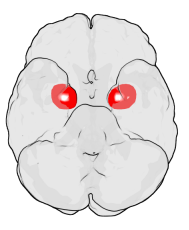 But what happens if these two brain regions don't work effectively together? Recent research suggests that unchecked amygdala responses can lead to addictive or compulsive responses as well as depression and schizophrenia. Whilst these observations are interesting it's not yet clear how we can apply them to treatment of such disorders. That's because the way different regions of the brain interact is immensely complex and so reliable results are often slow to come by. We are starting to make headway. With more research we hope to understand not only disordered emotion but what makes and shapes our very different and individual personalities.
But what happens if these two brain regions don't work effectively together? Recent research suggests that unchecked amygdala responses can lead to addictive or compulsive responses as well as depression and schizophrenia. Whilst these observations are interesting it's not yet clear how we can apply them to treatment of such disorders. That's because the way different regions of the brain interact is immensely complex and so reliable results are often slow to come by. We are starting to make headway. With more research we hope to understand not only disordered emotion but what makes and shapes our very different and individual personalities.
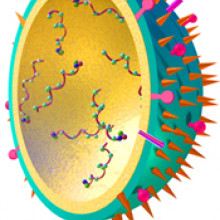
24:02 - Influenza - Flu Facts
Influenza - Flu Facts
with Ed Hutchinson, Cambridge University
We're talking about infectious diseases and foremost among them the thing which surprises most people actually kills about twelve thousand people every single year and that's influenza. Ed Hutchinson's a researcher from Cambridge University, so Ed, what is this beast that we all succumb to on a regular basis?
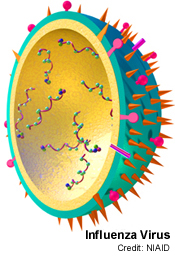 Ed - Well, for starters it's a virus and like all viruses it's incredibly small: 100nm across. That's about a quarter of the wavelength of visible light. Because it's so small it can replicate incredibly quickly but also because it's so small it really can't do anything. It really has to take over cells and get them to do all the jobs it needs.
Ed - Well, for starters it's a virus and like all viruses it's incredibly small: 100nm across. That's about a quarter of the wavelength of visible light. Because it's so small it can replicate incredibly quickly but also because it's so small it really can't do anything. It really has to take over cells and get them to do all the jobs it needs.
Chris - So you mean, because the virus is so tiny it doesn't have the machinery to copy itself so it needs to invade us, or things like us, to do that?
Ed - Exactly, it's traded off that ability in order to replicate very quickly.
Chris - Is it just us that get the flu?
Ed - No, it comes in several different types. The one we really worry about we call Influenza A and that infects a huge range of different creatures. It infects people but it also infects birds, we worry a lot about bird flu. It infects seals, it infect whales.
Chris - If you could see the flu what would the virus look like?
Ed - It looks a bit like a kidney bean really, or a baked bean floating around. It's this little oval thing. You would need a very powerful microscope, you'd need an electron microscope because it's far smaller than the wavelength of [visible] light. That's most viruses. Now some of the influenza viruses as well, stay the same width but extend out great, long filaments. The ones we spend most of our time studying are little baked bean-shaped things.
Chris - Why do they form these filaments?
Ed - That's not really very well understood. We know this happens in clinical isolates. It doesn't tend to have them when you're looking at them in the lab. But when they're growing in your throat sometimes these viruses grow out these big strands which extend upwards into the mucous which is covering the cells in your throat. We think it might have something to do with getting the virus coughed out and spread on from person to person. The way this virus spreads is that it gets into the mucous. You cough or you sneeze and if a handkerchief doesn't get in the way it then gets breathed in by someone else and they get infected.
Chris - Are handkerchiefs actually useful as a way of stopping it because it sounds like it's so tiny that a handkerchief which you can physically see through if you hold it up to the light, it doesn't seem like much of a barrier.
Ed - Yeah, but bear in mind you're not just coughing up a virus, you're coughing up a whole ball of snot as well so it is going to stick in your handkerchief.
Chris - I should point out at this point there's a wonderful article on our website this eek. It's been written by Becky Poole and it's all about why snot is green. If you go to thenakedscientists.com you'll see it's advertised there: all about the science of mucous to give it it's proper name. But Ed, carrying on with your guided tour of flu, what are the key points about it?
Ed - What you've got is really a box which has got the flu genes on the inside. On the outside it's got some proteins, the thing the virus is built of. These allow it to get in to cells and to get out again. These proteins grab on to cells and the virus gets inside. Within about 12 hours it's copied itself hundreds and hundreds of times. It's incredibly quick. Like I said, very small, very quick replication.
Chris - The incubation period of flu is incredibly short. When you think that most air travel for example, can bring you to the other side of the world and it takes 24 hours to do it. If you picked up flu on one side of te planet you could be infectious for it during touchdown.
Ed - It's a scary thought when you put it like that, yes.
Chris - How does it get into the cells that it needs to invade and then how does it take them over?
Ed - On the outside of the flu it's decorated with a little stalk called hemagglutinin. Now we tend to abbreviate that to HA or even H. That grabs onto the surface of the cell and pulls the virus inside. Once the virus is inside that box that holds the genes inside it opens up. The virus genes fall out into the centre of the cell. Then they just take the cell over and turn it into a factory for making more flu. When the virus gets out again as it assembles it uses another protein that decorates the outside of the virus called neuraminidase which we abbreviate to NA or N. That cuts it off from the cell and gets it out again. The reason I'm mentioning the hemagglutinin (the HA) and the neuraminidase (the NA) is because these cover the outside of viruses, they are protein building blocks recognised by the immune system. It's these things which antibodies stick to. It I for this reason when we talk about viruses we tend to categorise them by their hemagglutinin type and their neuraminidase type - their H type and their N type.
Chris - Like H5N1?
Ed - Exactly.
Chris - When this genetic virus goes in what's the genetic material it uses because people talk about the flu continuously coming back? If it was just the same infection every time people would be getting immune to it but we don't. Why is that?
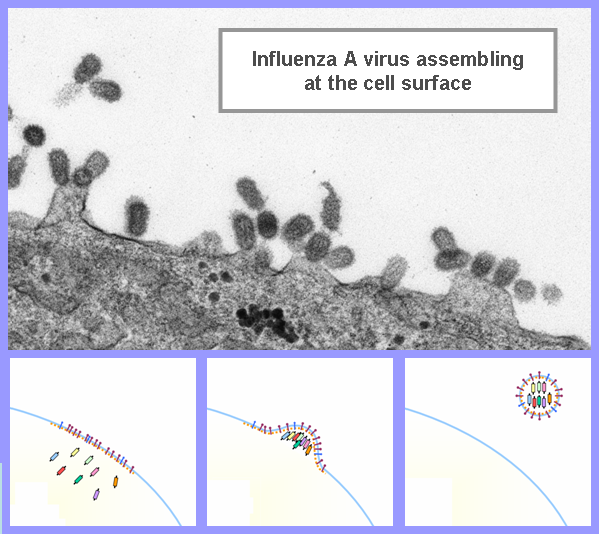 Ed - Flu mutates very, very rapidly. This is partly because it's genome, instead of being built of DNA (that's what we use), it's built of RNA. That's if you like a far more primitive thing to build a genome out of and is absolutely hopeless at copying so rapidly so flu is constantly mutating all the time. Because of this the vaccine which we use against flu needs to be constantly updated. There's another side to this as well. Every so often, we're talking a few times a century, flu will suddenly change. The H type and the N type will change to something completely different. That can be catastrophic. This is a disease which normally will kill 250-500 million people globally every year.
Ed - Flu mutates very, very rapidly. This is partly because it's genome, instead of being built of DNA (that's what we use), it's built of RNA. That's if you like a far more primitive thing to build a genome out of and is absolutely hopeless at copying so rapidly so flu is constantly mutating all the time. Because of this the vaccine which we use against flu needs to be constantly updated. There's another side to this as well. Every so often, we're talking a few times a century, flu will suddenly change. The H type and the N type will change to something completely different. That can be catastrophic. This is a disease which normally will kill 250-500 million people globally every year.
Chris - What you're talking about is a new pandemic. You get an epidemic which gently changes and turns into something that is devastatingly different.
Ed - Yes, exactly. These completely new viruses will sweep through the population.
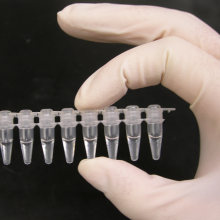
29:41 - Finding Flu Fast
Finding Flu Fast
with Martin Curran and Tim Wreghitt, Addenbrookes Hospital
It's time to find out about a revolutionary new way to diagnose our winter bugs in two hours rather than two weeks. It's going to lead to numerous benefits in treating flu and other respiratory viruses. We sent Meera to Addenbrooke's Hospital to find out more.
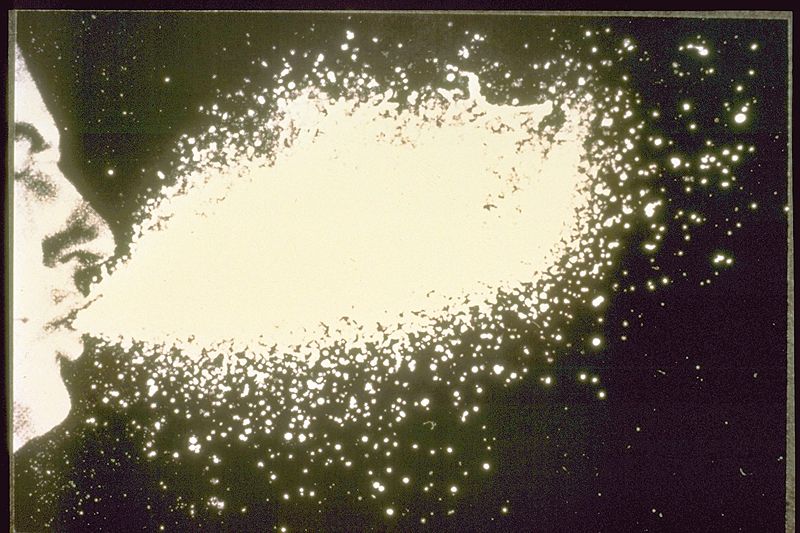 Meera - Know how that feels? I'm sure you do. Each year, we're all hit with either the flu, or if we're lucky, just the cold but it always seems to take ages to recover and even longer to get a clear diagnosis from the doctor about which bug is causing us to feel so unwell. Part of the problem is that there are hundreds of different viral infections. They all have slightly different characteristics which means they're difficult to identify on their own. To do it scientists either have to grow the offending virus in the laboratory or study the antibodies being made in the patients blood to find out what viruses they're fighting off. In both cases the process is really slow and patients have either recovered or deteriorated significantly by the time the diagnosis is made. Of course, these delays make it difficult for doctors to know how best to treat severely ill patients and to tell who should be isolated to prevent cross-infections in hospitals or out in the community. Now, a new technique developed by researchers at Addenbrooke's Hospital in Cambridge can identify some of the most common respiratory infections in less that two hours potentially solving many of these problems. It works by copying the nucleic acids, or in other words the DNA, or a related chemical called RNA within 8 of the most common virus infections that strike in the winter time including the flu virus. To detect which viruses are present in a patient's sample the researchers also add coloured probes which glow when they detect DNA from a specific virus. As the viral genetic material is copied it glows more and more brightly. By using different coloured probes to recognise different viruses all the team have to do is read off the colour of the solution to see which virus is there. If more than one virus is present it can tell that too. Martin Curran is one of the scientists behind the work.
Meera - Know how that feels? I'm sure you do. Each year, we're all hit with either the flu, or if we're lucky, just the cold but it always seems to take ages to recover and even longer to get a clear diagnosis from the doctor about which bug is causing us to feel so unwell. Part of the problem is that there are hundreds of different viral infections. They all have slightly different characteristics which means they're difficult to identify on their own. To do it scientists either have to grow the offending virus in the laboratory or study the antibodies being made in the patients blood to find out what viruses they're fighting off. In both cases the process is really slow and patients have either recovered or deteriorated significantly by the time the diagnosis is made. Of course, these delays make it difficult for doctors to know how best to treat severely ill patients and to tell who should be isolated to prevent cross-infections in hospitals or out in the community. Now, a new technique developed by researchers at Addenbrooke's Hospital in Cambridge can identify some of the most common respiratory infections in less that two hours potentially solving many of these problems. It works by copying the nucleic acids, or in other words the DNA, or a related chemical called RNA within 8 of the most common virus infections that strike in the winter time including the flu virus. To detect which viruses are present in a patient's sample the researchers also add coloured probes which glow when they detect DNA from a specific virus. As the viral genetic material is copied it glows more and more brightly. By using different coloured probes to recognise different viruses all the team have to do is read off the colour of the solution to see which virus is there. If more than one virus is present it can tell that too. Martin Curran is one of the scientists behind the work.
Martin - It uses fluorescent oligonucleotide probes that are mirror images of what you're amplifying: a little short stretch. Each of these have different labels on them. You can have a red, green, a blue or orange. So what happens is you can put these in to different viral targets and if you are amplifying specifically the virus of interest that will actually bind and you'll get a certain fluorescent reading from that. We can use different probes with different colours on and in effect do four or five different reactions in a single tube. We call that multiplexing: to screen for the thirteen or fourteen different viruses that can cause respiratory infections.
Meera - What kind of samples are you getting from patients in order to look for these viruses then?
Martin - We get a whole range - sometimes we get nasal-pharyngeal aspirates which are swabbed off the back of the throat. We get nose swabs or throat swabs. Certainly, we get some BALs (bronchoalveolar lavages) that are deep washes from deep down in the lung.
Meera - How do you get from these samples to actually putting them in a machine for analysis?
Martin - We get the samples and we strip off all the protein and all the virus and just purify the nucleic acid whether it's RNA or DNA. Then that sample will go into the real-time PCR.
Meera - What have the benefits been so far?
Martin - Previously, the sensitivity was poorer. You might only find 30% of your samples positive whereas with this new technology it's far more sensitive and our positivity rate for the samples that have come in is sitting at about 75%.
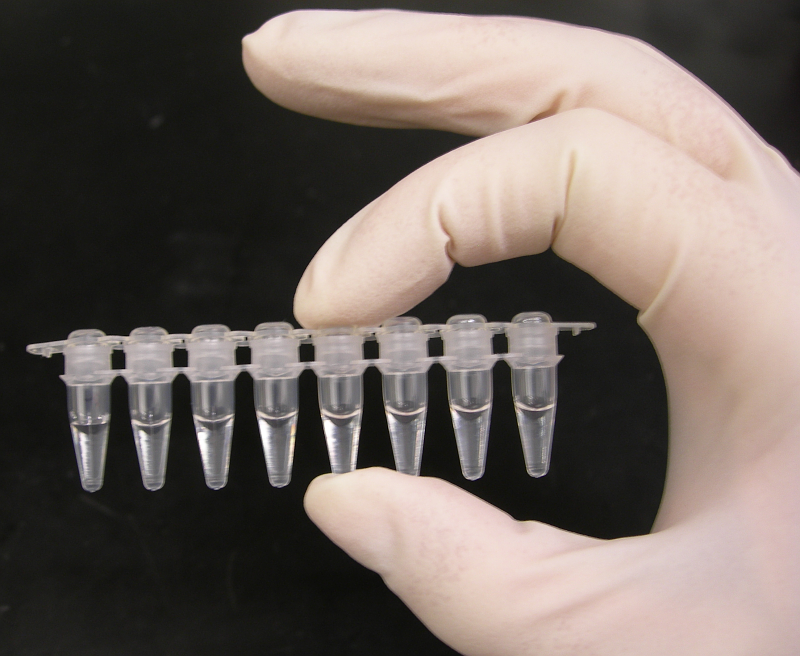 Meera - So we know how it's possible to get such a speedy and more accurate diagnosis. Has this made a difference in practise? I asked Tim Wreghitt, a consultant virologist, if there have been any benefits.
Meera - So we know how it's possible to get such a speedy and more accurate diagnosis. Has this made a difference in practise? I asked Tim Wreghitt, a consultant virologist, if there have been any benefits.
Tim - They've been quite substantial. First of all, it means that we can diagnose infections quicker. With the previous techniques we had which was largely virus culture it could take a week to get a result. If you're saying that patients need to be treated, for example, for influenza within 48 hours if you just did culture that would completely rule out them being treated.
Meera - I guess also a reduction in the amount of time will reduce the amount of spread of it.
Tim - Absolutely and that's very important. If you have, for example a patient in an intensive care unit you need to make sure that if the patient does have influenza you pick it up quickly. You can then make sure staff are vaccinated and that patients nearby are given prophylaxis. Equally, if we can identify the case quickly then we can review their treatment so if they're on antibiotics and there's no proven bacterial infection we can maybe take them off antibiotics and make sure they're on a proper antiviral and we have had cases here where that's happened. Patients have got better quite quickly.
Meera - I guess there's also a large benefit of taking people off antibiotics if they don't need them because they can develop resistance to things like that, can't they?
Tim - Absolutely, not only resistance but also they can develop side-effects. If you give certain antibiotics to people, particularly if they're older, then they are likely to develop very profuse, watery diarrhoea. The fewer people we have on antibiotics the better.
Meera - Since this technique has been in use in Addenbrooke's have there been any interesting findings?
Tim - There have. For example the increase in sensitivity means we have detected far more infections in patients with symptoms. So now as we're looking with more sensitive techniques we're beginning to understand the patients aren't necessarily infected with one virus. They may be infected with two or three. It's fair to say we're currently working through those to try and understand better which viruses are causing the symptoms.
Meera - The reason why some colds are worse than others could be because we're being hit by more than one bug at once. This real-time PCR technique can now rapidly identify some of the most common problem viruses allowing doctors to prescribe the right medication much more quickly and also to isolate patients more promptly preventing spread of infections. Gone are the days of just being sent away by the doctor with the line, 'it's a virus,' because in future you'll know which one and whether you really do have a good reason to take a day off work.
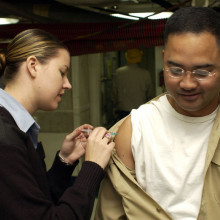
36:43 - Virus Vaccination
Virus Vaccination
with Dr John Wood, NIBSC
Well we've already heard about how flu actually causes disease, how it invades us, how it hijacks our cells and makes us feel generally grotty but how do we actually prevent it? John Wood is from the NIBSC, that's the National Institute of Biological Standards and Controls which means he works with flu vaccines. Hi John.
John - Hello.
Chris - What's in a flu vaccine that prevents us from getting sick and does it actually work?
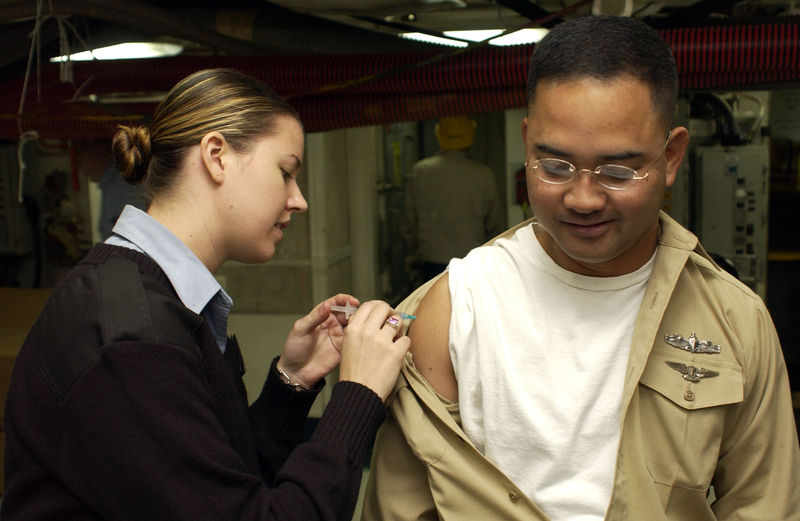 John - Most of the flu vaccines are produced by growing the virus in hens' eggs. The viruses are purified from the hen's egg fluids. They're chemically treated so they're no longer capable of infecting people. These purified virus particles or components of them are used to give to patients by inter-muscular injection. This, in turn, stimulates the body's immune system into thinking they've been invaded by flu.
John - Most of the flu vaccines are produced by growing the virus in hens' eggs. The viruses are purified from the hen's egg fluids. They're chemically treated so they're no longer capable of infecting people. These purified virus particles or components of them are used to give to patients by inter-muscular injection. This, in turn, stimulates the body's immune system into thinking they've been invaded by flu.
Chris - You're showing this viral shrapnel to the immune system so that it gets a sneaky preview of what the virus looks like. It makes an immune response: does it make as good an immune response as if you actually catch the flu?
John - It's thought not. The best way is stimulating a robust immune response which will give you protection for months and months to come is an infection itself.
Chris - We had an email from Mark in Bletchley who says, 'I've been in contact with someone who's had the flu quite badly but I didn't catch it. Why would that be?'
John - Well, I don't know the particular circumstances. It's possible, I hope, that maybe he had a vaccine but maybe not. He could have been exposed to flu in the past which gave him some immunity. Maybe he didn't know he'd been exposed to flu in the past. It may have been a kind of sub-clinical infection he didn't notice. I expect he had some kind of immunity.
Chris - Ed was saying the flu mutates as it goes around the world and this is why we get consistent outbreaks year on year. How do you make sure the vaccine is going to work every year?
John - This is a big problem and the WHO has a worldwide network of laboratories. They have over 120 so-called national influenza centres around the world. They monitor the newly emerging flu viruses. They analyse them and compare them with the previous years' flu viruses. Specifically, they're looking at the surface proteins to see how much they vary because these are the hypervariable part of the virus. The activities of these national centres are coordinated by four collaborating WHO centres. We have one here in the UK at Mill Hill in London, one at CDC in Atlanta, one in Tokyo and one in Melbourne. The directors of these centres come together twice a year in Geneva, the headquarters of the WHO to analyse all the data. I'm unfortunate that I'm asked along because they like to have some of the key regulating laboratories as well. We have to deal with the fall-out from any new strain. We look at all the data, we look at how the immune system was stimulated by last year's vaccine, recognises the vaccine. We look at the genetic properties of the new viruses, how these viruses react with the immune system and we make a prediction of which strains are likely to cause flu next year.
Chris - Is this based on viruses that are doing the rounds in the southern hemisphere? So when it's their summer and it's our winter here we're collecting viruses at the moment. Are we going to send them to their flu season next year so they can make vaccine?
John - It often does happen like that, yes. I said the WHO experts meet twice a year: once for the northern hemisphere recommendation and that's coming up in the next month and one for the southern hemisphere recommendation which is usually September. If you monitor very carefully what happens in the other hemisphere it's a very good indication what we're going to get next year.
Chris - Lots of people are saying if we're going have a pandemic of flu why are people worrying about antiviral drugs that are, at best, not very good? Why aren't we making a vaccine against pandemic flu?
John - We are making - we are trying to develop vaccines against pandemic flu. There are huge problems in trying to make the vaccines against pandemic flu. If we think it's going to be H5N1 there are lots of different varieties of H5N1 that are causing infections, lethal infections in birds. Well over six genetic groups have been recognised of H5N1. You will expect that a vaccine produced from one of these genetic groups may not give you protection against another one. There's no way of knowing which one would actually cause a pandemic in the future.
Chris - It sounds like a horrible pun but you don't want to put all your eggs in one basket; put all your vaccine into one particular type that might not end up being that type which causes the infection?
John - That's correct. You don't even know that it's going to be H5N1. It could be an old pandemic virus such as H2N2 from 1957-68.
Chris - I've got an email here from Ryan Bradley who says, 'I try to hold my sneezes in at least to have the air coming out of my mouth as opposed to my nose. The reason is I don't like spewing mucous out of my nose, onto my hands and other people.' The pressure doesn't bother me so I was wondering if this practise is at all detrimental to my health or if it defeats the purpose of needing to sneeze.'
John - I think it sounds a little bit dangerous practise to me.
Chris - We've had a call from John in Colchester who says, 'what about long haul flights when moving viruses around the world. This must be a major consideration and are there steps taken to sterilise the air on aeroplanes and things like that?'
John - I don't think steps have been taken to sterilise the air but certainly talking to people who've been on long haul flights they often complain of respiratory symptoms after the flights because the air is re-circulated. The tourist class syndrome, they think they're getting worse air than business class. I really don't know the mechanics of this.
Chris - Thank you very much, John.
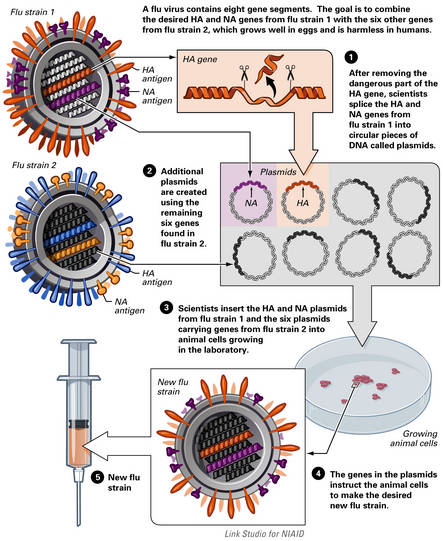

Treadmill runway?
Tim Sabey, Pilot & Ex-physicist:In order to take off, an aircraft must have sufficient vertical forces to counteract its weight. The major component of this upwards force is lift. Lift is generated by airflow over the wings creating a lower pressure distribution on the upper surface compared with the lower. This has the effect of deflecting air downwards as it passes over the wing. The equal and opposite reaction force of this is upwards and called lift. Lift is dependent on the aircraft speed so the aircraft must be at sufficient speed, typically 130-150kts for a commercial jet to take off. The second upwards force is the vertical component of the engine's thrust as when the aircraft nose is pitched up part of the thrust vector will be vertical. The aircraft will accelerate down the runway by its engines. These accelerate air backwards and again the equal and opposite reaction force on the plane is in the forwards direction, known as thrust. In the situation described there is a conveyor belt which automatically tracks the aircraft ground speed and moves at that speed but in the opposite direction. Since the aircraft is not accelerated by means of contact with the ground (like a car does) the only effect will be that the wheels spin faster so there is more friction. The aircraft will still be able to accelerate to a speed that produces enough lift to take off. This will increase the runway length required but given that is sufficient it will still be able to take off.Diana: If a plane was to reach take-off speed from motorised wheels:Terry Holloway, Marshall Cambridge, Group Support Executive:In this particular instance the assumption is that the aeroplane is sitting on this mobile conveyor belt runway. As the aeroplane gains speed and goes forward so the conveyor goes backwards at an identical speed. Let us say hypothetically that this particular aeroplane that we're talking about would normally take off at 100 miles per hour. When it reaches a forward speed of 100mph, in other words its wheels on the runway, the conveyor is going backwards at 100mph but the aeroplane's speed through the air is zero. There's no air flowing over the aerofoil section of the wing which produces the lift. Therefore the aeroplane won't fly.
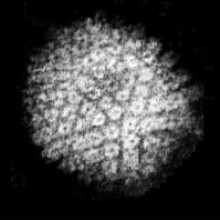
Where do viruses come from?
We put this question to Cambridge University Researcher Ed Hutchinson...
In the case of flu, you've got the fact that flu will spread from organism to organism so although we're worried particularly about a human virus, or a virus of livestock as well, it actually starts off as a virus in waterfowl. Things like ducks, where it's not really a pathogen at all - it just lives in there and gets along with them. That doesn't really tell you where a virus has come from. We know that they can spread from organism to organism.
In the first place viruses probably evolve as just bits of the genetic sequence which just get out of hand and start copying themselves, moving to places they shouldn't and acquiring more and more abilities along the way. There are quite a few examples of this where thing start jumping around inside genomes eventually will get the ability to jump from cell to cell as well.
Chris - In the answer to what came first, chicken or the egg, the virus-cell situation has to be the cell came first, the virus came later?
Ed - Remember, the defining feature of the virus is that it's absolutely dependent on taking over a cell to work. Without a cell the virus isn't going to do anything at all...
Can you pass on colsore virus without having a coldsore?
We put this question to Cambridge University researcher Ed Hutchinson:
I'm afraid, unfortunately the answer is sometimes, yes you can. Cold sores belong to a family of viruses called herpes viruses. These don't just include the famous sort of herpes we've all heard of but a whole range of viruses. These viruses have a nasty trick of causing visible infection then hiding and coming back at various points in your life. It's called latency. If the cold sore's happening it's hiding in some nerves in the side of your head and they're coming back into you're mouth on a regular basis. Sometimes this is going to cause a visible cold sore and sometimes it's going to cause something you can't see but it's still going to be shedding infectious virus into your saliva. I'm afraid it's always a risk.











Comments
Add a comment